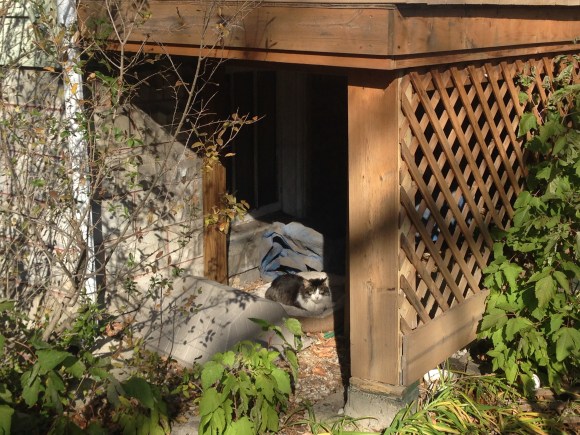Hyde Park Cats 2016 Calendar Now Available – Cats in My Yard Featured for October
We are included again (!!!) in the Hyde Park Cats calendar for 2016.
This highlighted link includes instructions on how to order this calendar from hydeparkcats.org
Every cat in a trap here has a story that deserves to be shared and celebrated, which is pretty much why I started this blog in the first place. Here are their stories:

From left to right, top to bottom:
FIRST ROW, left to right:
Ferret, from the Jose and the Pussycats Colony, TNR’d in February 2012, and still feral and thriving outdoors. She has a cat bed outdoors with fresh, clean blankets every day.

Frostie MacCreamsicle, also from the Jose and the Pussycats Colony, TNR’d in March 2012. He is friendly so I fostered him and he was adopted by my friends, Eliya and Mary.

Whip, the orange cat, is from the Boonie Colony, TNR’d in March 2015. We have not seen him since he was TNReturned outside, but he comes from a very large colony that is fed daily by a feeder who lets the cats in and out of his basement.

I trapped this tabby cat from the Eleanor Rigby Colony in March 2015. I let him go right away – he was already ear tipped but I don’t know who originally TNR’d him. There are multiple feeders on every block in this area.

SECOND ROW, left to right:
Wally, the black cat, from the V Colony, was TNR’d in May 2014. He was very friendly and very sick – the first vet I took him to advised me to euthanize him. I took him to another vet for a second opinion. He tested positive for FeLV, then reversed the test results, and was adopted by my friends Carlin and Kathy in St. Louis. Now over a year later he is still very much alive and thriving in their home.

Garfield, the long-haired orange cat from the Armando Colony, was TNR’d in December 2014. I still see him periodically when I visit.

Mala, the black cat, also from the Armando Colony, was TNR’d in December 2014. She was very feral and also returned to Armando’s house once she recovered from her surgery.

Cosmo Moon Eyes, this black and white cat from the Peacock Colony, was TNR’d in August 2014. He is still around and being fed according to his feeder, Ashley, a young girl in junior high who learned all about TNR from this process.

THIRD ROW, left to right:
Mr. Friendly, the brown tabby and white cat from the Rockstar Colony, definitely lived up to his name. He was TNR’d in February 2012 and his feeders wanted to keep him as an indoor/outdoor cat. He was still thriving later that year and I would see him periodically throughout the neighborhood. Unfortunately the following year he was killed by a car. My rescue neighbor and friend Kim found him and gave him a proper burial as he deserved. RIP Mr. Friendly.

None, the grey cat, was the first to be TNR’d from the Chester Colony in March 2015.

Joann tried to foster her indoors for a bit, but None turned out to be feral and was ultimately returned outside. Their feeder Chester feeds daily and they have shelter in this garage.

Popcorn, the brown and white tabby from the front yard of my very own colony, James Gang Colony, was TNR’d in September 2014. I named him Popcorn because he kept trying to pop out of the trap and made a mess inside the entire time. He is feral and still visits my front yard feeding station at night, although I have no idea where he goes otherwise.

Apple, also from the Chester Colony, was about five months old when we trapped her and her sister Ava in March 2015. Joann could not bear to put them back outside without trying to socialize them first. She ended up keeping both of these sisters where they are living their lives indoors with her and her other five pet cats.

We can’t wait to get these calendars to distribute as gifts for the holidays!








































Congratulations!! TNR does work as long as there are caring, committed humans to help.
Thanks, Jean!